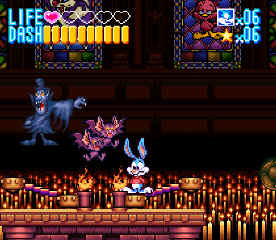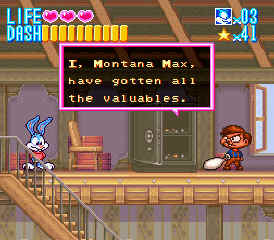The Magic Touch In Which Konami’s Buster Busts Loose is Scrutinized  | A Castlevania moment |
Works of art don’t always turn out the way they were first conceptualized: artists and writers will tell you this all the time. An odd shape on a painting may have started out as a mistake; a pop song’s catchy hook might have been a wrong key played on a piano. Videogames are no different: there are reasons for how and why games turn out the way they do. Sometimes, reasons that change the original scope of a game come along during production, and influence what the finished product looks like. But the main factor that determines the quality of a game, money and deadline constraints aside, are the hearts and souls of the people behind it.
 | A Tiny Toon take on Castlevania | Today, huge teams of programmers and designers work hard to bring you their producer’s vision. Like all works of art, a little piece of the designers goes into every game. It’s easy to spot the designer’s influence in games programmed for the classic systems, where a single person was usually in charge of all aspects of a games’ creation. Despite the system’s limitations, the best games are the ones in which the fruits of the creator’s labor really come through in the finished product. This “magic touch” was, and still is, what elevates mere programming to high art and keeps gamers coming back for more. One of the main reasons gamers buy sequels is the hope of recapturing some of that magic touch. Today’s games are more of a challenge to get this magic into, as the vision of the original creator gets kicked down to a team of hundreds of designers and programmers. In the 16-bit era however, development teams of only about 15-30 people worked on a game; although the mark of an individual programmer was difficult to pinpoint, given the relative complexity of 16-bit games, the finished product clearly had the entire development team’s magic touch stamped all over it.  | Buster getting his dash on | This magic touch is important to gamers, especially those who collect games from a franchise, gamers who like to play certain genres, and for those who, like myself, aim to preserve videogame history. By analyzing a team’s style, we can see where developers made mistakes, implemented new ideas, and made gradual improvements. For example, Capcom’s Darkstalkers trilogy was a testing ground for new graphical styles and fighting engine tweaks that were incorporated into later Street Fighter titles. Developers like Konami put inside jokes in their games that the hardcore fans will appreciate, such as the numerous cameos in Snatcher. Elements of a particular style such as these might not be obvious while playing a game at first, until the player makes it a note to actively keep an eye out for them.  | Go Acme Looniversity! | Before Dance Dance Revolution and Yu-Gi-Oh, Konami had a repertoire of fast-paced arcade games like Contra and Teenage Mutant Ninja Turtles. Pumping quarters into the machine and mashing on the buttons was the sure-fire way to win at these quarter-munching monster hits. At the same time, Konami’s console games like Castlevania and Metal Gear favored repetition-based gameplay, and required the player to memorize obstacle/enemy patterns to win. In the early 1990’s, Super Nintendo and Sega Genesis were the twin superpowers in the console wars. The Super Nintendo clearly had superior graphics and sound capabilities, while Genesis boasted blazing fast gameplay (“blast processing” was just a marketing ploy, but the Genesis’ 10mHz processor and true-and tried Motorola chips made the system easy for programmers to work with). Fewer copies of gritty-looking Genesis games would sell when the same title was available for the Super NES, however. To neutralize this trend, developers including Konami started developing original games that were custom tailored to each consoles’ strengths and weaknesses. Thus, we saw TMNT: The Hyperstone Heist on Genesis, which featured tons of action and on-screen sprites, while TMNT 4: Turtles in Time came to the Super Nintendo, boasting exclusive levels and arcade-quality graphics. Capitalizing on the popularity of the weekday afternoon show Tiny Toon Adventures, Konami acquired the license to develop games based the cartoon on for all platforms. Following the aforementioned practice of developing games around the capabilities of a system, Konami’s Sonic-clone Buster’s Hidden Treasure hit the Genesis, while their platformer Buster Busts Loose was released for the SNES.  | Montana Max' award-winning dialogue | There is hardly a better example of a development team’s magic touch than Buster Busts Loose, released in 1993. Several members of Treasure (for whom we credit the fantastic games Castlevania and Contra for NES, the Genesis game Gunstar Heroes, and Ikaruga for Dreamcast, among many others) had a hand in programming this game, and it shows. The gameplay is characteristic of Konami’s action games of the time: enemy pattern recognition and environmental obstacles abound. Buster Busts Loose is strictly an action game; that is, the story doesn’t develop over the course of the game according to what the player does. The minigames between stages are noteworthy, because of their great variety and high quality. From Calamity Coyote’s Championship Squash to Plucky’s Bingo Shoot to Hungry Boy Hampton (a slide-puzzle game), so much thought went into the mini-games that they are usually just as fun as the main game. The graphics are lush and colorful: sprites are large, detailed, and well animated for the time. The backgrounds and stages fit in well with the theme of the TV show. Also, tons of good guys and villains from the show made it into the game, from “Ah-nuld” the buffed-out pit bull to Duck Vader.  | Plucky's BINGO shoot | Highlights of the game include the football game stage against Perfecto Prep, in which Buster’s team has four downs to score a touchdown. In this stage, the gameplay differs from the rest of the levels, as Buster can only dash over and under the opposing team to gain yards in a run, or has QB Plucky Duck pass throw him a long pass. With its colorful graphics and challenging gameplay, Buster Busts Loose is an above-average platform game, and a fine example of action/platform games of its day. Players should keep a look out for subtle movie references, nods to other Konami games, and the odd Mode 7 graphical eye-candy. Konami fans, Treasure devotees, and platform game aficionados everywhere need to give this one a try for its historical value, as well as its fun and challenge.
 | Sonic 2... erm... Buster's Hidden Treasure | Buster Busts Loose
Developer: Konami Co., Ltd.
Publisher: Konami of America, Inc.
Distributor: GTI, Electro Source
Year: 1993
Similar games: Mega Man 8, Bubsy, Rocket Knight Adventures |







